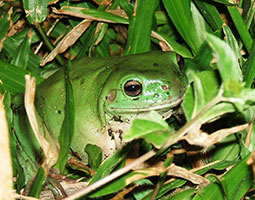Litoria caerulea
Description

The Green Tree Frog (Litoria caerulea) is one of the most commonly encountered frogs due to their habit of occupying man-made items such as toilets, gutters and letterboxes. They are large frogs that can grow to 12 centimetres in length, with smooth green skin on the dorsal (upper) surface and white below.
Fingers and toes have large discs and webbing which makes them both good climbers and swimmers. Breeding occeurs from November to January, with the eggs laid in jelly mats on the surface of still water in clumps of 200 - 2000 eggs. Tadpoles are brown to green in colour and take approximately six weeks before changing into adults (Metamorphosis).
Adaptations
- Excellent camouflage
- Large eyes enable them to see at night
- Discs on toes help them to climb almost any surface.
- Large numbers of eggs helps increase the chances of survival for offspring
- Long-lived (up to 20 years)
Feeding relationships
- What I eat: As a tadpole—algae; As a frog—invertebrates, other frogs, small lizards, small mice
- What eats me: As a tadpole—fish, birds, spiders and dragonfly larvae; As a frog— snakes (e.g. Green Tree Snake & Red-bellied Black Snake), Owls, Tawny frogmouth
Interesting facts
A frog's sticky tongue is attached at the front so that it can dart out at prey before being swallowed alive. I also use my eyes to help me push food down my throat when I swallow.